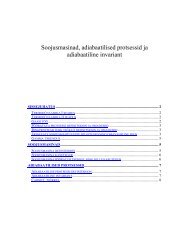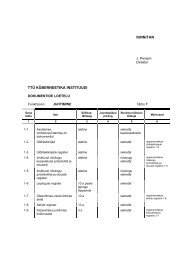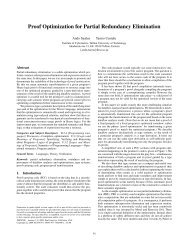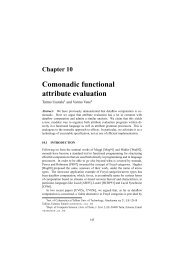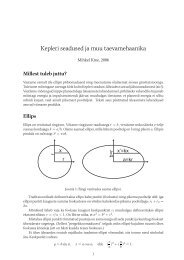NUMERICAL STABILITY OF MASS LUMPING SCHEMES FOR ...
NUMERICAL STABILITY OF MASS LUMPING SCHEMES FOR ...
NUMERICAL STABILITY OF MASS LUMPING SCHEMES FOR ...
You also want an ePaper? Increase the reach of your titles
YUMPU automatically turns print PDFs into web optimized ePapers that Google loves.
Contents• Finite element dispersion errorbilinear versus serendipity elementsnumerical examples• Effect of time integrationexplicit and implicit schemesmass lumpingnumerical stability• Conclusions
Dispersion curvesAfter Newton, Kelvin, Born . . .mü i = k(u i−1 − 2u i + u i+1 )solution formu i = û sin K(x i − ct)wave numberK = 2π Λ = ω csolvability conditionc = function(ω)
Finite element method• Belytschko, T., Mullen, R.: On dispersive properties of finite element solutions,In: Modern Problems in Elastic Wave Propagation. Wiley 1978.• Abboud, N.N., Pinsky, P.M.: Finite element dispersion analysis for the threedimensionalsecond-order scalar wave equation. Int. J. Num. Meth. Engrg.,35, pp. 1183–1218, 1992.
Numerical test• Plane strain square domain 100 × 100 serendipity finite elements• Unit material propertiesYoung’s modulus E = 1Poisson’s ratio ν = 0.3density ρ = 1• Pointwise harmonic loading in the horizontal directionF x = ˆF x sin ωtωH/c 1 stepped by 0.1 increment• Newmark’s method with small Courant numbertime integration effect disabledCo = c 1 ∆t/H = 0.01
frequency ωH/c 1 =0.5
Contact-impact problem of two cylinderslv 0v 0laGeometry: a = 2.5 mm, l = 6.25 mmMaterial parameters:E = 2.1 × 10 5 MPa, ν = 0.3, ρ = 7800 kg/m 3Initial condition: v 0 = 5 [m/s]Theoretical position of wave fronts in colliding cylindersc 1 t/a = 0.8 c 1 t/a = 2
Contents• Finite element dispersion errorbilinear versus serendipity elementsnumerical examples• Effect of time integrationexplicit and implicit schemesmass lumpingnumerical stability• Conclusions
Newmark methodDiscrete operator(K + 4 )( 4∆t 2M u t+∆t = R t+∆t + M + 2 ∆t 2ut ∆t ˙ut + ∆tüt 4 )Dispersion curvesCo = 0.00–0.25 Co = 0.25–1.00Insensitive to time step for Co ≤ 0.25.
Mass matrix lumpingRow sum and Hinton-Rock-Zienkiewicz methods used.21.81.6linearquadraticcc l1.41.210.80.60.4consistentmass matrix0.2lumpedmass matrix00 0.1 0.2 0.3 0.4 0.5H / λSimilar performance—advantage lost.
1: No service related investments are mentioned in the annual report2: A company made some operating investments (e.g. new software program to better help thecustomers) or got involved in operational service partnerships or agreements3: A company expanded its service network or restructured its organizational structure in order toprovide more or better services to its customers3: A company started a strategic joint venture that concerns services4: A company made a service-related acquisition (e.g. acquired another firm that has bothproduct and service offering)5: A company made one service acquisition or several service-related acquisitions5: A company formed a separate service divisionThe distinction should be made between the proof of investment and intent to invest: while in thecase of the former we can find some tangible evidence of the investments, in case of the latter weare just encountering declarations in form of promises. We would take a claim of investment intoaccount for „Service investments‟ variable only if the proof of investment has been provided.This notion is as important for the interpretation of the variables, as it is necessary for theappropriate treatment of the sources we have. Given that in annual reports, firms hope to presentthemselves optimally to the stakeholders, we need to make a clear distinction between what is aproof and what is an unproven statement (David, 2001).“Service completeness” describes the depth of a firm‟s involvement with clients and the scopeof client‟s service needs that manufacturer is prepared to cover. Service completeness is used tograde manufacturers according to their value proposition and inclusiveness of their service14
Optimum mass distribution(central difference method, Co = 0.5)Dispersion suppressed as x → 0.25.
Contents• Finite element dispersion errorbilinear versus serendipity elementsnumerical examples• Effect of time integrationexplicit and implicit schemesmass lumpingnumerical stability• Conclusions
Numerical stability• Fried, I.: Discretization and round-off errors in the finite element analysis of elliptic boundaryvalue problems and eigenproblems. Ph.D thesis, MIT, 1971.• Dokainish, M.A., Subbaraj, K.: A survey of direct time-integration methods in computationalstructural dynamics - I. Explicit methods. Computers and Structures, 32(6), pp1371–1386, 1989.Stability condition∆t ≤ ∆t cr = 2ω maxEstimation of the maximum eigenvaluesup ω(H/λ) ≤ ω max ≤H/λ∈(0;0.5)max ω max(m)m=1,nelem
Critical Courant numberbounding eienvalueslumping optimizationCo crit0.50.4dispersion analysiseigenfrequenciesCo crit0.50.40.30.3consistent mass matrix0.20.20.10.100 0.05 0.1 0.15 0.2 0.25x00 0.05 0.1 0.15 0.2 0.25xRemark 1: Critical Courant number for the consistent mass matrix is 0.25.Remark 2: Critical Courant number for x = 0.23 is 0.21.
Conclusions• Threshold values of the time step for bilinear elements:Co = 0.5 (Newmark, consistent, best accuracy)Co = 1.0 (CDM, row sum lumping, stability)• The same for serendipity elementsCo = 0.25 (Newmark, consistent, best accuracy)Co = 0.25 (CDM, HRZ lumping, stability)Co = 0.20 (CDM, x=0.23 lumping, stability)



